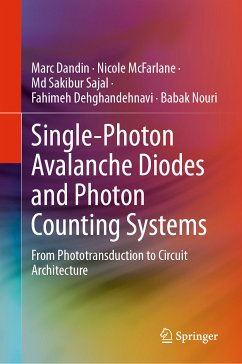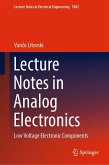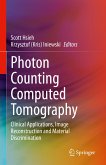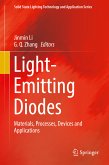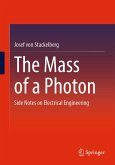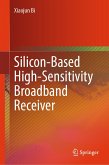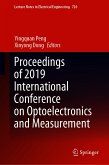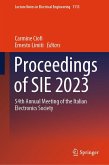Single-Photon Avalanche Diodes and Photon Counting Systems (eBook, PDF)
From Phototransduction to Circuit Architecture


Alle Infos zum eBook verschenken

Single-Photon Avalanche Diodes and Photon Counting Systems (eBook, PDF)
From Phototransduction to Circuit Architecture
- Format: PDF
- Merkliste
- Auf die Merkliste
- Bewerten Bewerten
- Teilen
- Produkt teilen
- Produkterinnerung
- Produkterinnerung

Hier können Sie sich einloggen

Bitte loggen Sie sich zunächst in Ihr Kundenkonto ein oder registrieren Sie sich bei bücher.de, um das eBook-Abo tolino select nutzen zu können.
This book covers the latest trends in the design of single-photon avalanche diodes (SPADs), which are the front-end sensors in modern photon counting systems. The authors describe the fundamental physics that enable photon counting in these devices. They also discuss systems that are made from these detectors, specifically describing circuit architectures that may be used to achieve high-fidelity photon counting. Coverage features example devices and systems designed in the authors' research groups as well as different approaches undertaken by other experts in the field.
The authors take a…mehr
- Geräte: PC
- ohne Kopierschutz
- eBook Hilfe
- Größe: 16.12MB
![Lecture Notes in Analog Electronics (eBook, PDF) Lecture Notes in Analog Electronics (eBook, PDF)]() Vanco LitovskiLecture Notes in Analog Electronics (eBook, PDF)56,95 €
Vanco LitovskiLecture Notes in Analog Electronics (eBook, PDF)56,95 €![Photon Counting Computed Tomography (eBook, PDF) Photon Counting Computed Tomography (eBook, PDF)]() Photon Counting Computed Tomography (eBook, PDF)52,95 €
Photon Counting Computed Tomography (eBook, PDF)52,95 €![Light-Emitting Diodes (eBook, PDF) Light-Emitting Diodes (eBook, PDF)]() Light-Emitting Diodes (eBook, PDF)112,95 €
Light-Emitting Diodes (eBook, PDF)112,95 €![The Mass of a Photon (eBook, PDF) The Mass of a Photon (eBook, PDF)]() Josef von StackelbergThe Mass of a Photon (eBook, PDF)72,95 €
Josef von StackelbergThe Mass of a Photon (eBook, PDF)72,95 €![Silicon-Based High-Sensitivity Broadband Receiver (eBook, PDF) Silicon-Based High-Sensitivity Broadband Receiver (eBook, PDF)]() Xiaojun BiSilicon-Based High-Sensitivity Broadband Receiver (eBook, PDF)112,95 €
Xiaojun BiSilicon-Based High-Sensitivity Broadband Receiver (eBook, PDF)112,95 €![Proceedings of 2019 International Conference on Optoelectronics and Measurement (eBook, PDF) Proceedings of 2019 International Conference on Optoelectronics and Measurement (eBook, PDF)]() Proceedings of 2019 International Conference on Optoelectronics and Measurement (eBook, PDF)167,95 €
Proceedings of 2019 International Conference on Optoelectronics and Measurement (eBook, PDF)167,95 €![Proceedings of SIE 2023 (eBook, PDF) Proceedings of SIE 2023 (eBook, PDF)]() Proceedings of SIE 2023 (eBook, PDF)167,95 €
Proceedings of SIE 2023 (eBook, PDF)167,95 €-
-
-
The authors take a unique, modular approach that covers every aspect of the design stack, with stand-alone chapters, allowing readers to focus on specific aspects of the technology stack. Coverage includes the device-physics aspects of the detectors, their integration in modern electronics fabrication technologies like CMOS, and application-specific systems that utilize these detectors.
Dieser Download kann aus rechtlichen Gründen nur mit Rechnungsadresse in A, B, BG, CY, CZ, D, DK, EW, E, FIN, F, GR, HR, H, IRL, I, LT, L, LR, M, NL, PL, P, R, S, SLO, SK ausgeliefert werden.
- Produktdetails
- Verlag: Springer Nature Switzerland
- Seitenzahl: 184
- Erscheinungstermin: 31. August 2024
- Englisch
- ISBN-13: 9783031643347
- Artikelnr.: 71505551
- Verlag: Springer Nature Switzerland
- Seitenzahl: 184
- Erscheinungstermin: 31. August 2024
- Englisch
- ISBN-13: 9783031643347
- Artikelnr.: 71505551
- Herstellerkennzeichnung Die Herstellerinformationen sind derzeit nicht verfügbar.
Fahimeh Dehghandehnavi received her B.S. degree in Electrical and Electronic Engineering in 2019 from the University of Tehran, Tehran, Iran, and her M.S. in Electrical and Computer Engineering in 2022 from Carnegie Mellon University, Pittsburgh, PA, USA. Currently, she is a Ph.D. candidate in the Department of Electrical and Computer Engineering at Carnegie Mellon University. Her doctoral research focuses on CMOS sensors ranging from pg-SPAD imagers to capacitance biosensors. Babak Nouri earned the B.S. degree in Electrical Engineering from George Mason University, the M.S. degree in Electrical Engineering from the Virginia Polytechnic Institute, and the PhD degree in Electrical Engineering, from the University of Maryland, College Park. His doctoral research at the University of Maryland (College Park), focused on the design, simulation, fabrication and testing of integrated single-photon sensing and processing systems based on single-photon avalanche diode (SPAD) pixel detectors. Notably, his worked focused on the design, development and testing of: large-area digital SPAD pixels structurally adapted for ultra-low dark noise levels, with specialized front-end electronics for high digital throughput; SPAD-based digital readout detector arrays with on-chip analog encoding of aggregated digital pixel outputs ; integrated decoding architectures for free-running digitization and readout of SPAD-based digital pixel arrays, and on novel analytical models for improved dead time corrections in SPAD front-ends. He also has served as an adjunct professor in advanced analog electronic design at the George Washington University (GWU), and as a guest technical reviewer for the Optics Express journal.
